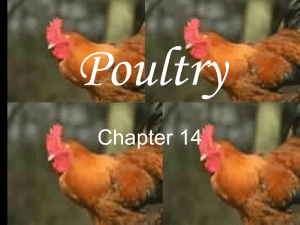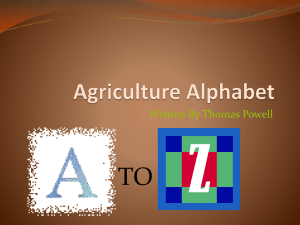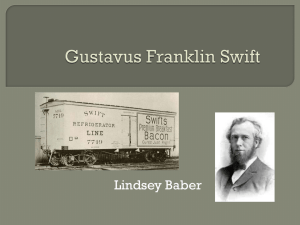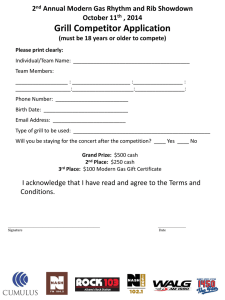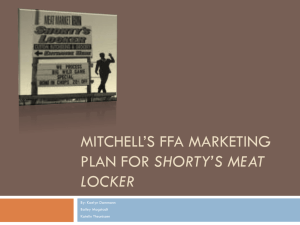Meat, Poultry, and Seafood
advertisement
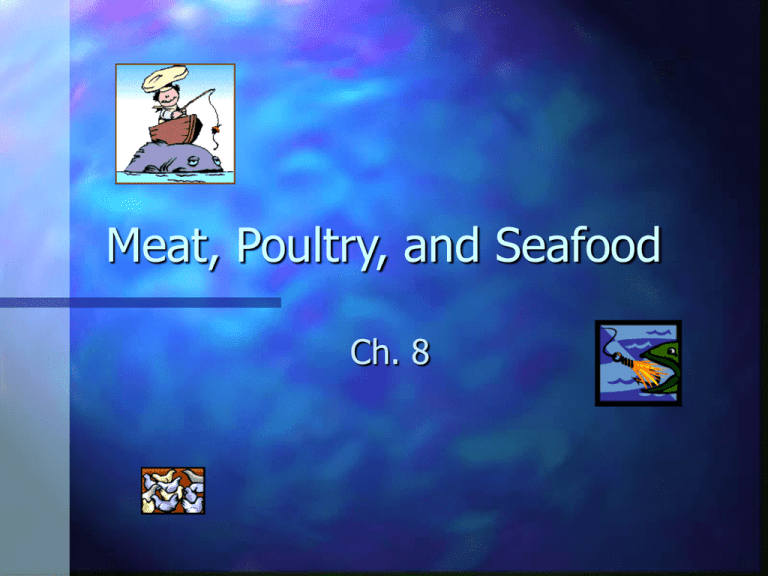
Meat, Poultry, and Seafood Ch. 8 Purchasing, Storing, and Preparing Meats, Poultry and Seafood 8.1 Purchasing Meat • Serving meat is one of the most expensive, yet profitable areas • Meat can be purchase from a whole carcass to individual cuts of meat • Government inspection is mandatory • U.S. Dept. of Agriculture has established grades called quality grades • Quality Grade = standards given to meats based on their freshness and quality • Yield Grade = refers to the amount of usable meat after the fat has been trimmed (this only applies to lamb and beef) Storing Meats • Sanitary procedures must be followed when storing meats • Meat should be loosely wrapped in airpermeable paper and stored under refrigeration. • Never tightly wrap fresh meats in plastic wrap because this creates a perfect breading ground for bacteria and will severely limit the shelf life. Butchering Meats • Cattle butchered for beef is cut into 4 sections. Cattle that is butchered from age of one day up to fifteen weeks are cut into two halves and sold as veal. • Hogs are slaughtered and cut into two halves. • Sheep slaughtered under the age of one year are considered lamb; after that age them must be labeled mutton. Lambs are cut directly into primal cuts. • Primal cuts = are primary divisions of meat produced by the initial butchering of animal carcasses. Aging Meats • Meat must be aged between 48 and 72 hours to allow the muscles to relax. • Butchers hang the meat during aging to help lengthen the muscle fibers and increase the tenderness of the meat. • Meat that is aged longer becomes more expensive because the carcass looses more water which shrink the meat. Fabrication • At the end of the aging period, the carcass is then cut into primal cuts • Look at page 343 in your book • Fabrication = is the process of cutting primal cuts into usable potions • Retail cuts =cuts that are ready for sale. • They can be primal cuts or fabricated portions • The amount of cutting or butchering necessary to prepare a retail cut affects its price. Fabrication Continued • Tying = a roast ensures even cooking and keeps the shape of the meat. • Trimming = a tenderloin must be done very carefully because it is one of the most expensive cuts • Silverskin = tough membrane that surrounds the meat • Butterflying = cut a piece of meat lengthwise nearly in half so that it opens out and lies flat. Fabrication Continued • Cuts from boneless loin or tenderloin of beef, veal, lamb, or pork can be made into a variety of menu cuts: • Medallions – small, round pieces molded by wrapping them • Noisettes – small, usually round portion of meat • Scallops – thin, boneless cuts that are lightly pounded • Emince – thin strips of meat used for sautéing Other Meats • Offal meats = are organ meats from hogs, cattle or sheet • Sweetbread (thymus glands), liver, kidney, tripe (muscular stomach lining), hear and brain • Game meats = are form animals that are not raise domestically • Deer, wild boar, moose and elk • Kosher meat = meats are especially slaughtered to comply with Jewish dietary laws Purchasing Poultry • Poultry = include chicken, duck, goose, guinea, squab, turkey etc. • Like beef, poultry also goes under mandatory inspection • Quality grades are • USDA A USDA B USDA C • Factors that determine grade are: shape of carcass, ratio of meat to bone, amount of feathers, hair, and don and number (if any) of cuts or broken bones Storing Poultry • All types of fresh poultry should be wrapped loosely and stored under refrigeration between 32°F-36°F • Free-range poultry = raised in large yards and given a lot of space to roam and exercise their muscles • This makes meat darker in color and gives the meat a slight different taste and texture. • Game birds (rising interest) Poultry Fabrication • Poultry fabrication includes • Disjointing and boning (separating meat from bones) – page 348-349 • Not all birds are fabricated some birds are left whole and trussed = which means the legs and wings are tied to the bird’s body so the entire bird cooks evenly and stays moist Purchasing Fish and Shellfish • Fish and shellfish inspections are not required by the federal government, there is a voluntary program called Packed Under Federal Inspection (PUFI) • After passing inspection fish is given a grade of A, B, or C grade • Fish is highly perishable – they should be moist, firm, elastic flesh, clear and full eyes, gills should have a bright red color • Live crabs and lobster should move about Purchasing Fish and Shellfish Continued • Most shellfish are purchased live and must be checked to make sure they are fresh when received. • Tightly closed shells • Reject any delivery containing open shells that wont close or broken shells • To help ensure safety the FDA requires that all foodservice establishments keep dated shell stock tags from shellfish for 90 days. • There are two basic categories of fish: • Fin Fish • Flat – flounder, sole halibut • Round fin fish – cod, grouper, red snapper, catfish, trout etc. • Shellfish • Mollusks – oysters, clams, mussels • Crustaceans – lobster, shrimp, crab Storing Fish and Shellfish • Fresh fish should be stored in crushed ice in a refrigerated unit – used within 3 days, preferably within one day of delivery. • Fresh shellfish should be stored in a covered container in a refrigerated unit. Fabricating Fish and Shellfish • Fin fish fabricated • Most of the trim can be put to use in the kitchen by a soup, sauce, canapé etc. • Fish fabrication techniques consist of • Scaling, trimming, gutting, and filleting the fish • Scaling = scales are scarped off their skin. • Gutting round fish = slit is made in the fish’s bells and the guts, or insides are pulled out • Gutting flat fish = cut are made around the head, as the head is pulled away from the body, the guts come with it. • Filleting = separates the flesh of the fish from the bones • Goujonetts – small strips • Paupiettes – thin rolled files filled w/a stuffing Mollusks and Crustaceans • Two classifications of shellfish • Mollusks = shellfish characterized by a soft, unsegmented body, no internal skeleton and a hard out shell. Ex. clams • Shucked = removed from the shell (do not destroy shell) • Crustaceans = have segmented shells and jointed legs. Ex. lobsters • Deveining = process of removing a shrimp’s digestive tract. Questions 8.1 Match the term with the definition 1. Fabrication 2. 3. 4. Silverskin Agining Yield grade 5. Veal 6. Mutton 7. Primal cuts 8. 9. 10. Retail cuts Medallions Noisettes a. Small, round piece of meat molded by wrapping in cheesecloth b. Little “nuts” of meat c. Sheep slaughtered after the age of 1 d. Working with primal cuts of meat to customize them e. Cattle that are butchered from the age of 1 day to 15 weeks f. The amount of usable meat after the fat has been trimmed g. Gives meat a darker color and also makes it more expensive h. Tough membrane on meat i. Leg, loin, rib, and shoulder cuts K. Cuts ready for sale Cooking Meat, Poultry and Seafood 8.2 Meat Composition • Muscle tissue consists of about: • • • • 75% Water 20% Protein 5% Fat Add is made up of a network of muscle fibers bound together in bundles • Each of the fibers is surrounded by connective tissues, there are two types of connective tissue: • Collagen – breaks down during long, slow, moist heat cooking • Elastin = will not break down during cooking and needs to be trimmed • The amount of connective tissue in a muscle increases as the animal ages and the more the animal is exercised. • Marbling = fat that builds up between the muscle fibers Flavor, Tenderness, and Moisture • Goal is make meat flavor and tender. • The reduction in collagen increases the tenderness of the meat, but at the same time, the los of moisture dries it out. • Moist-heat methods are generally slower and allow collagen to break down. • Tender pieces of meat use quick dry-heat method. • Marinade = a liquid made of oil, acid and herbs and spices. (acid in the marinade breaks down the collagen) • Dry marinade/spice rub = combination of dry herbs, spices, and salt to give extra flavor. • Bard = tying bacon to a roast to add fat and flavor Searing = caramelize outside of meat, improving flavor and appearance of finished product Dry-Heat Cooking Meats best suited to dry-heat, are meat that is naturally tender. Dry heat with fats = stir-frying ,pan-frying and deep-frying • Mirepoix = a combination of chopped aromatic vegetables (usually 2 parts onion, 1 part carrot and 1 part celery) • Jus = sauce that incorporates drippings released during roasting • Deglazing = swirl a liquid in a pan to dissolve cooked particles or food remaining on the bottom. (au jus) • Pan gravy = is a sauce thickened with a roux incorporation the fat from a roast and adding water or stock. • Carryover cooking = heat retained in cooked foods that allows continued cooking even after item I removed from the oven. Moist-heat Cooking These are for cuts of meat that are tough. Combination Cooking- uses both dry and moist heat cooking methods Determining Doneness • One of the most important steps: • Beef Roasts • Rare – 130F (meat red on the inside, thin layer of brown) • Medium – 140-145F (meat will be pink, well browned outside) • Well-done -160F (completely cooked) • Allow meat to REST, very important, juices goes back into the meat. AT LEAST 10 MINUTES • Veal and Pork – cooked all the way thru • Pork could contain trichinosis = a disease caused by a parasite that lives in muscle tissue – cook until internal temperature of 150F Dry-Heat Cooking for Poultry • Juices need to be colorless • Roasting requires a longer cooking time because this techniques is used to cook a whole bird • Cooked until thermometer reaches 150165F to kill all traces of salmonella • Dressing for birds need to be made separately Cooking Poultry • Poultry is especially suited for dry-heat cooking with fats/oils • Includes sautéing, stir-frying, pan=frying and deep-frying • Steaming is a healthy way to prepare poultry because the nutrients are not washed away (Flesh of poultry should be opaque) Simmering and poaching are also excellent techniques • Combination cooking includes stewing and braising, good cooking technique because nutrients goes into the sauce Cooking Fish and Seafood • Most fish are baked between 350°F-400°F. • Large fish need to be baked at a lower temperature so the entire fish will bake evenly • Lean fish and shellfish are best when using dry-heat cooking with fats and oil • Fish/Shellfish should be coated with flour or a breading before cooking in either clarified butter or oil • Moist-heat cooking techniques – poaching, simmering, and steaming are excellent ways to cook fish, especially lean varieties • Court bouillon = stock made of vegetables and an acid • Fumet = rich fish stock made with wine, or simmered in its own juices Cooking Fish and Seafood Continued • Shallow-poached fish and shellfish should be opaque. • Finished item should be moist and extremely tender • Cooking muscles, clams etc. make sure the shell opens during cooking otherwise throw them AWAY • En papillote = moist-heat cooking techniques that is especially suited to fish (the fish herb etc are encased in parchment paper and steamed in a hot oven) Cooking Fish and Seafood Continued • Bouillabaisse = French seafood stew made with assorted fish and shellfish, onions, tomatoes, white wine, olive oil, garlic, saffron and herbs • Jambalaya = Creole stew from Louisiana made with rice, shellfish and vegetables • Seafood Newburg = lobster, crab or shrimp in a rich sauce made from butter, cream, egg yolks, sherry and seasoning. 8.2 Questions 1. Identify the cooking techniques below as A (dry-heat), B (dry-heat cooking with fat), C (moist heat), or D (combination cooking) 1. 2. 3. 4. 5. 6. 7. 8. Grilling Sautéing Stewing Poaching Braising Stir-frying Broiling Simmering 2. Why do you marinate your meat? 3. Large birds are often trussed because? Charcuterie and Garde-manger 8.3 • Charcuterie = “cooked flesh”, refers to specially prepared pork products include sausages, smoked hams, bacon, pates, and terrines • Garde-manager = refers to a kitchen’s pantry section where these cold foods are stored and the work area where they are prepared. Sausage • Traditionally sausage were ground pork, forced into a casing made from the lining of animal intestines • Today many other meats are very popular including game, beef, veal, poultry, fish, shellfish and even vegetables. • There are three main types of sausage: • Fresh sausage – made with raw ingredients ex. Kielbasa or chorizo • Smoked or cooked sausage – raw meat products treated with preservatives ex. bratwurst or frankfurter • Dried or hard sausage – made with cured meats, then air-dried ex Italian salami and pepperoni Forcemeats • Forcemeat = mixture of lean ground meat and fat that is emulsified or forced to combine in a food grinder and then pushed through a sieve to create a smooth paste. • Pate = rich loaf made of meat, game, poultry, seafood, and/or vegetables, baked in a mold. • Straight forcemeats = very finely ground, seasoned with herbs and spices and then cooked in earthenware mold called a terrine. • Sometimes the forcemeat is wrapped in a dough and placed in a terrine mold, also different vegetables are arranged in terrines to make this appetizer. Forcemeat Continued • Mousseline = forcemeat made of veal, poultry or fish. • Can be shaped into dumpling-shaped ovals and poached in a rich stock or court bouillon to make quenelles • Galantine = are traditionally made of chicken forcemeat, but is now ,and with a number of different meats. • Forcemeat is rolled into a round loaf inside the chicken skin, then poached for up to an hour and a half. 8.3 Questions 1. Mousseline 2. 3. Quenelle Terrine 4. Galantine 5. Sausage 6. Fresh sausage 7. 8. Smoked sausage Dried or hard sausage 9. Forcemeat 10. Pate dough a. Ground meat forced into a casing made of animal intestines b. Forcemeat made of veal, poultry or fish c. Small dumpling shaped ovals poached in a rich stock d. Mixture of lean ground meat and fat forced through a sieve e. Chicken forcemeat rolled in chicken skin and poached f. Forcemeat rolled in pate dough and baked in an earthenware mold g. Crust surrounding a baking forcemeat h. Sausage made with fresh ingredients that have not been cured or smoked i. Sausage made with raw meat products treated with preservatives j. Sausage made with cured meats, then airdried under sanitary conditions



